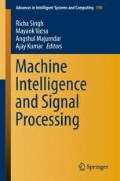Abstract
Face detection has been an active area of research for several decades. As a result, efficient algorithms and implementations have been developed for several practical applications. These advancements have led to significant increase in the scope of face detection research. Adapting existing detectors to different yet related domains is one such extension over the traditional scope. In this setup, the adaptation is performed when only one or a few images are available from the target domain, whereas none of the images from the source domain are available. This chapter discusses two of the recent algorithms that address this problem.
Access this chapter
Tax calculation will be finalised at checkout
Purchases are for personal use only
Notes
- 1.
This strategy is similar to the suggestion made by Viola and Jones [6] for selecting certain model parameters.
- 2.
- 3.
While it is common to make a pre-trained classification cascade available, it is often not feasible to retain the examples used for training it due to operational and copyright issues.
- 4.
In fact, the main characters in six of the top 10 highest-grossing hollywood movies of the year 2012 are non-human characters that have appearances with strong similarity to humans.
References
Yang, M., Wu, Y., Crenshaw, J., Augustine, B., Mareachen, R.: Face detection for automatic exposure control in handheld camera. In: International Conference on Computer Vision Systems (2006)
Froba, B., Ernst, A.: Fast frontal-view face detection using a multi-path decision tree. In: Proceedings of Audio- and Video-Based Biometric Person Authentication (2003)
Pham, M.T., Cham, T.J.: Fast training and selection of Haar features using statistics in boosting-based face detection. In: International Conference on Computer Vision (2007)
Osadchy, M., LeCun, Y., Miller, M.L.: Synergistic face detection and pose estimation with energy-based models. J. Mach. Learn. Res. 8, 1197–1215 (2007)
Jain, V.: Using context to enhance the understanding of face images. Ph.D. thesis, University of Massachusetts Amherst (2010)
Viola, P.A., Jones, M.J.: Robust real-time face detection. Int. J. Comput. Vis. 57(2), 137–154 (2004)
Zhang, C., Zhang, Z.: A survey of recent advances in face detection. Technical report, Microsoft Research (2010)
Rowley, H.A., Baluja, S., Kanade, T.: Neural network-based face detection. IEEE Trans. Pattern Anal. Mach. Intell. (1998)
Schneiderman, H., Kanade, T.: Probabilistic modeling of local appearance and spatial relationships for object recognition. In: IEEE Conference on Computer Vision and Pattern Recognition (1998)
Blitzer, J., Crammer, K., Kulesza, A., Pereira, F., Wortman, J.: Learning bounds for domain adaptation. In: Advances in Neural Information Processing Systems (2008)
Corduneanu, A., Jaakkola, T.: On information regularization. In: Conference on Uncertainty in Artificial Intelligence (2003)
Daumé III, H., Marcu, D.: Domain adaptation for statistical classifiers. J. Artif. Intell. Res. 26, 101–126 (2006)
Lawrence, N.D., Jordan, M.I.: Semi-supervised learning via Gaussian processes. In: Advances in Neural Information Processing Systems (2005)
Zhu, X.: Semi-supervised learning with graphs. Ph.D. thesis, Carnegie Mellon University (2005)
Rasmussen, C.E., Williams, C.K.I.: Gaussian Processes for Machine Learning. The MIT Press (2005)
Jain, V., Learned-Miller, E.: Online domain adaptation of a pre-trained cascade of classifiers. In: IEEE Conference on Computer Vision and Pattern Recognition (2011)
Jain, V., Learned-Miller, E.: FDDB: a benchmark for face detection in unconstrained settings. Technical report, University of Massachusetts Amherst (2010)
Mikolajczyk, K., Schmid, C., Zisserman, A.: Human detection based on a probabilistic assembly of robust part detectors. In: European Conference on Computer Vision, pp. 69–82 (2004)
Jain, V., Farfade, S.S.: Adapting classification cascades to new domains. In: International Conference on Computer Vision (2013)
Lee, D.D., Seung, H.S.: Algorithms for non-negative matrix factorization. In: Advances in Neural Information Processing Systems (2000)
Szummer, M., Jaakkola, T.: Information regularization with partially labelled datas. In: Advances in Neural Information Processing Systems (2002)
Belkin, M., Niyogi, P., Sindhwani, V.: Manifold regularization: A geometric framework for learning from labeled and unlabeled examples. J. Mach. Learn. Res. 7, 2399–2434 (2006)
Bickel, S., Brückner, M., Scheffer, T.: Discriminative learning under covariate shift. J. Mach. Learn. Res. 10, 2137–2155 (2009)
Author information
Authors and Affiliations
Corresponding author
Editor information
Editors and Affiliations
Rights and permissions
Copyright information
© 2016 Springer India
About this paper
Cite this paper
Jain, V. (2016). Domain Adaptation for Face Detection. In: Singh, R., Vatsa, M., Majumdar, A., Kumar, A. (eds) Machine Intelligence and Signal Processing. Advances in Intelligent Systems and Computing, vol 390. Springer, New Delhi. https://doi.org/10.1007/978-81-322-2625-3_4
Download citation
DOI: https://doi.org/10.1007/978-81-322-2625-3_4
Published:
Publisher Name: Springer, New Delhi
Print ISBN: 978-81-322-2624-6
Online ISBN: 978-81-322-2625-3
eBook Packages: EngineeringEngineering (R0)

